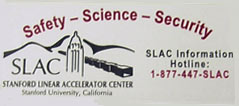
Handy Links
SLAC News Center
SLAC Today
- Subscribe
- Archives: Feb 2006-May 20, 2011
- Archives: May 23, 2011 and later
- Submit Feedback or Story Ideas
- About SLAC Today
SLAC News
Lab News
- Interactions
- Lightsources.org
- ILC NewsLine
- Int'l Science Grid This Week
- Fermilab Today
- Berkeley Lab News
- @brookhaven TODAY
- DOE Pulse
- CERN Courier
- DESY inForm
- US / LHC
SLAC Links
- Emergency
- Safety
- Policy Repository
- Site Entry Form

- Site Maps
- M & O Review
- Computing Status & Calendar
- SLAC Colloquium
- SLACspeak
- SLACspace
- SLAC Logo
- Café Menu
- Flea Market
- Web E-mail
- Marguerite Shuttle
- Discount Commuter Passes
-
Award Reporting Form
- SPIRES
- SciDoc
- Activity Groups
- Library
Stanford
Around the Bay
From the Director: Safety
 I chose yesterday for the Security and Safety Briefing deliberately. Three years ago to the day we had a terrible accident at this lab. Those of you who were here at that time will not forget the accident or the months after it. I know I won't. Three years later we can ask: Is the lab safer?
I chose yesterday for the Security and Safety Briefing deliberately. Three years ago to the day we had a terrible accident at this lab. Those of you who were here at that time will not forget the accident or the months after it. I know I won't. Three years later we can ask: Is the lab safer?
The answer is certainly yes. Safety awareness is much greater and safety standards are much higher, but is the lab where it needs to be in terms of our goal to be an accident-free work environment? Definitely not.
Four weeks ago, we received a wake-up call when a PVC pipe at Sector 30 exploded. We were very, very lucky that there were no serious injuries. We cannot, must not depend on luck to avoid a devastating accident.
Over the past three weeks, I've been watching as a SLAC team analyzes what went wrong at Sector 30. They have done a superb job, helped by outside expertise. The have concluded that the explosion did not just happen because "someone screwed up." They found more than one point in the management chain when the accident could have and should have been prevented. We must understand the failures, acknowledge them and use them to help us plan to avoid such problems in the future.
The Sector 30 incident shows us that we are not 'there yet' in terms of our safety standards and practices at the lab. In the financial year that just closed, we had almost a 60% increase in accidents involving lost or restricted time—an average of almost two cases per month. That's two of our coworkers each month who suffered an injury that was significant enough to keep them from doing their job. We are not meeting my expectations and I hope we are not meeting your expectations for where we need to be.
To achieve our goal, safety must be a core value at SLAC, just as outstanding science is a core value. Safety is not the responsibility solely of ES&H. We, as individuals and as a team, are accountable for our safety.
As individuals, we should integrate safety into everything we do. Always think "safety" before you act. Make sure you know how to carry out any task safely, and if you're uncertain, your safety coordinator or ES&H can help.
As a community, we must be watchful for each other. Remember, a serious accident at one part of the site could shut down the entire laboratory. I expect active and visible engagement by the entire management team starting with me and going down to the first line supervisor to keep safety in the forefront.
If an accident does occur, I implore you to report it. A near miss, a first aid case, a minor injury: these are the signs that something is wrong. We don't want to overlook the warnings and have a severe accident.
We've made progress since October 2004, but we need to do more and we need your help. I welcome your input on how things could work better, so please feel free to provide feedback. Only by working together can we meet this challenge and truly excel in our science mission.
—Persis Drell, SLAC Today, October 12, 2007